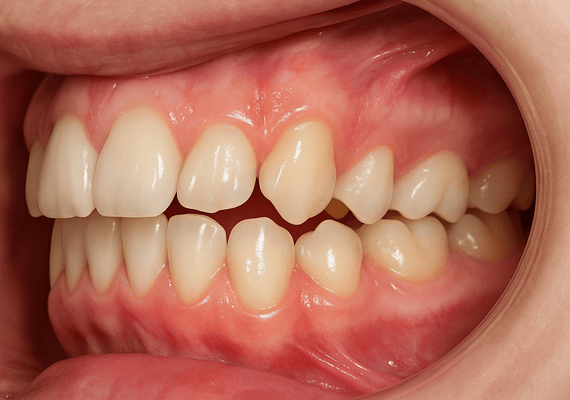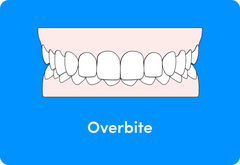Key takeaways
A deep bite, also known as an overbite or closed bite, is a type of malocclusion where the upper front teeth excessively overlap the lower front teeth. This condition can be caused by genetics, facial structure, or habits and can lead to issues like uneven tooth wear, gum damage, jaw pain, speech difficulties, and problems with breathing. Treatment options range from braces and clear aligners to more invasive methods like surgical orthodontics for severe cases.
Symptoms and complications
Excessive overlap: The upper front teeth cover a significant portion of the lower front teeth.
Tooth and gum damage: The lower teeth can bite into the gums behind the upper teeth, leading to pain, ulcers, and gum recession.
Uneven wear: The excessive bite can cause excessive and uneven wear on the enamel of both the upper and lower front teeth.
Speech impediments: Difficulty in pronouncing certain sounds due to tongue movement being restricted.
Breathing problems: In severe cases, the jaw's position can restrict the airway, potentially leading to sleep apnea.
Jaw pain: A deep bite can contribute to temporomandibular joint (TMJ) disorders and jaw pain.
Difficulty chewing: Some foods may be difficult to chew properly.
Causes
Genetics: An inherited skeletal structure or tooth size discrepancy between upper and lower jaws.
Tooth size: The upper front teeth may be larger than normal, or the lower front teeth smaller than normal.
Growth patterns: The natural growth pattern of the jaw can lead to a deep bite.
Habits: Tongue thrusting, where the tongue pushes against the teeth during swallowing, can contribute to the problem.
Missing teeth: The loss of back teeth can cause the remaining teeth to shift, creating a deep bite.
Treatment options
Braces: Traditional braces apply continuous pressure to move teeth into the correct alignment.
Clear aligners: Custom-made trays that gradually move the teeth into the desired position, similar to braces but often removable.
Dental restoration: In cases with worn teeth, treatments like composite bonding, veneers, or crowns may be needed to rebuild the tooth structure.
Dahl appliance: A removable orthodontic appliance that may be used to help correct the bite.
Orthognathic surgery: In severe cases, especially in adults, surgery may be required to reposition the jaw bones.
Table of Content
What is a deep bite?
A deep bite, also known as an overbite, occurs when there is a significant overlap of your upper front teeth over your lower front teeth. A small overlap is normal. But a pronounced overlap can lead to various dental problems. With that in mind, the next step is to understand how a deep bite differs from a normal bite.
|
Condition |
Deep Bite |
Normal Bite |
|
Teeth Overlap |
Upper front teeth excessively overlap the lower front teeth (more than 4 mm). |
Upper front teeth slightly overlap the lower front teeth (about 1-2 mm). |
|
Alignment |
The balance between the jaw and teeth is disrupted. |
Jaws are properly aligned, allowing smooth movement and balanced bite force. |
|
Chewing efficiency |
Deep overlap, leading to Limited jaw movement and reduced chewing efficiency. |
Slight overlap, with a full range of jaw movement and greater chewing efficiency. |
|
Enamel loss |
Uneven wear due to misaligned bite, especially the back of front teeth and the biting surface of lower teeth. |
Minimal or normal on the tooth surfaces. |
|
Aesthetic Appeal |
A smile may appear “short,” or teeth may seem to cover the lower lip. |
While smiling, teeth appear balanced. |
|
Potential Issues |
It can lead to TMJ disorders, gum irritation, and speech or breathing issues. |
Mostly healthy oral function. |
|
Common Age Group |
More common in children and adults with untreated orthodontic issues or prolonged habits like thumb sucking or teeth grinding. |
Across all age groups, with healthy development. |
Having a clear understanding of both types of bites will help you recognize the issue at an early stage. To avoid the associated issues, it is recommended to start the deep bite treatment between the ages of five to nine years.
That said, what is the underlying cause of a deep bite? We're discussing that next.
What are the causes of a deep bite?
Deep bite can be caused by multiple elements, ranging from genetic to behavioral factors. Let's discuss them in detail.
Genetics
Genetics can always play a major role in your dental development. A family history of malocclusion increases the chances of developing a deep bite yourself. Inherited factors such as the size and shape of your teeth can significantly influence how your bite forms.
Jaw misalignments
Jaw misalignments can be of various types, causing the development of a deep bite. The most common cause is the underdeveloped or small lower jaw, which results in upper teeth protruding forward to cover the lower ones. Sometimes the lower jaw rotates backward and upwards, resulting in a shorter vertical dimension.
Crowded teeth
This type of malocclusion creates an insufficient space for the teeth to erupt correctly, causing the upper front teeth to overlap the lower ones excessively.
Oral habits
Some oral habits are developed from birth, which result in malocclusion in adulthood. Like, thumb sucking can push the front teeth forward and cause the back teeth to move closer together, increasing the vertical overlap. Now, is it even necessary to treat a deep bite? What if we leave it as it is? Well, then it leads to further complications.
What are the complications of a deep bite?
Since a deep bite creates increased pressure on the front teeth, it can lead to several complications, like oral health, jaw function, and facial imbalance. Here is what you need to know about the potential complications of a deep bite.
Dental problems
Constant pressure from lower teeth on the gums, behind the upper teeth, can also cause gum recession. In some cases, continuous rubbing against the roof of the mouth may also cause discomfort, sores, or ulcers.
Jaw and facial complications
A deep bite puts extra pressure on the joints, which can trigger jaw pain, stiffness, headaches, and TMD or temporomandibular joint disorders.
Other health complications
Issues caused by an overbite go beyond misaligned teeth. They are not limited to chewing problems or bad aesthetics. In fact, a deep bite can cause gum disease due to dryness in the mouth from breathing.
By now, we all know that misaligned teeth aren't just about looks — they can cause real dental problems too. But don't worry; we've got the right treatment options to help you out.
Treatment options for deep bite
Before we get into the question you're wondering, how to fix deep bite? No one solution will work for all types of overbite. Let's discover some different treatment options.
Orthodontics

Deep bite braces are one of the traditional methods. These brackets and wires will slowly reposition your teeth. But if you have a mild to moderate deep bite, simply go for clear aligners. Not only will they solve it discreetly, they'll also keep your hygiene and comfort intact.
Fix a deep bite the smarter way
With Caspersmile Clear Aligners, experience comfort, convenience, and confidence — all without hassle.

Restorative Dentistry
Restorative dentistry is used for severe overbite issues. In some cases, it can involve full-mouth rehabilitation using methods like crowns, implants, or bridgework to rebuild the missing tooth and achieve a proper bite.
Dahl appliance
The Dahl appliance is a specialized platform used to fix an overbite. It sits on your front teeth, separating your upper and lower teeth. Allowing them to gradually move and grow into contact again. This appliance does not require the removal of enamel and helps create a balanced bite.
Orthodontic surgery

Some overbites are very complex to treat. An orthodontic surgery is for those severe cases that cannot be fixed by braces or clear aligners alone. In this procedure, the teeth are aligned to be prepared for the surgery and then operated on to reposition the jaw movement.
Early intervention for kids
Deep bite correction should be done at the right time, preferably early on. Otherwise, it can further damage the tooth structure. Monitoring jaw growth and early oral habits can prevent the development of deep bites. This can include using orthodontic appliances during growth to guide the growth of the jaw and teeth.
Every case is different; it is dealt on the basis of severity, growth, age, genetics and etc. In case you're not clear about your case, it is important to consult your dentist as soon as possible. And if you wish to learn more, check out.
Treat your deep bite the right way
A deep bite isn't just a cosmetic issue — it's a serious dental health concern that can affect your bite, jaw function, and overall oral health. The good news? There are plenty of effective ways to fix it, from clear aligners to advanced surgical options. The right treatment, though. depends on the severity of your condition.
If you've got a severe deep bite, braces or orthodontic surgery can be the best options. If it's mild to moderate, Caspersmile clear aligners are the best treatment option. Overall, just don't neglect it. Once you get it treated, you'll clearly notice how it improves your bite function and looks.
Frequently asked questions

References
Silver, N. (2020, August 31). Deep bite: more than a cosmetic issue.
Healthline.
https://www.healthline.com/health/deep-bite-more-than-a-cosmetic-issue
Overbite. (2025b, August 18). Cleveland Clinic. https://my.clevelandclinic.org/health/diseases/21473-overbite
Subscribe our newsletter
By clicking subscribe, you agree to our Privacy Policy and opt in to receive communications from Caspersmile. You can unsubscribe at any time.



